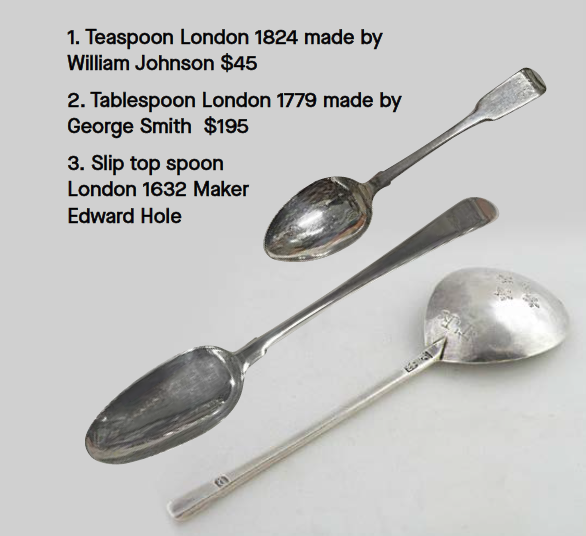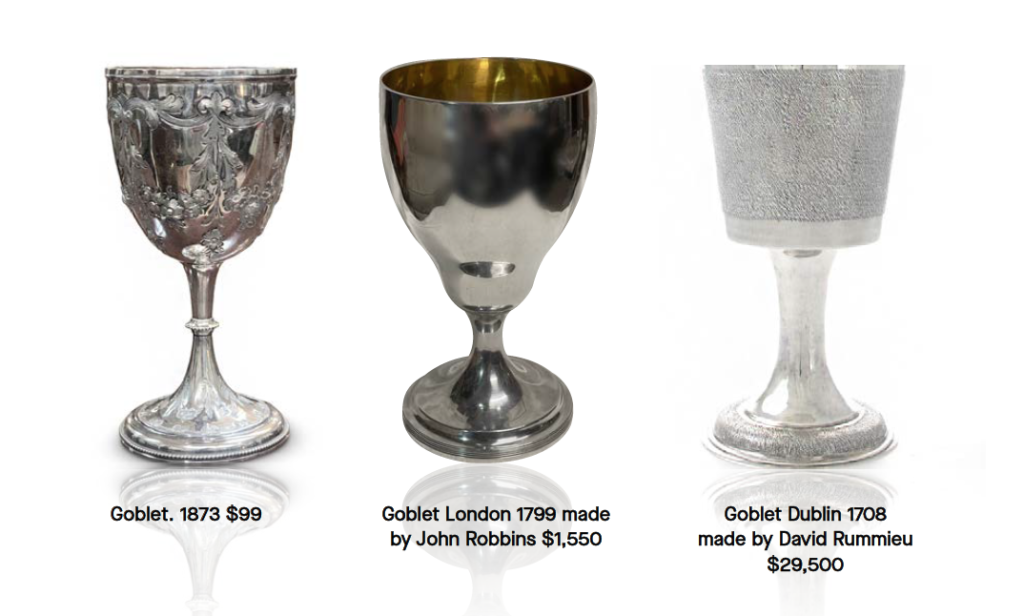Article
GOOD, BETTER BEST. SILVER FOR EVERY POCKET.
SILVER SOCIETY OF AUSTRALIA
One of the nicest things about collecting silver is that you can find objects that you can actually use without fear of chipping or breaking them. Furthermore, you can find useful items in almost every price range.

If you come from a generation that eats avocado whole, you can enhance the pleasure of eating it with a Georgian teaspoon at a cost of well under $100. The shape of an early George III fiddle pattern teaspoon is perfectly suited to scooping the avocado out of its skin. If you are of the younger generation, using a silver fork to smash it onto your multigrain sourdough will enhance the pleasure of preparing it. The marks on it will tell you where it was made, when it was made and who made it.
Further up the price scale you could consider collecting eighteenth century forks and spoons to be used on special occasions. These range in price from $100 to $300 each and are readily bought singly or in sets. You shouldn’t put them in the dishwasher but it you wash and dry them by hand you will find that you will not have to polish them.
At the upper range of the market a slip top spoon makes a perfect soup spoon. These were all made before 1650 and are a forerunner of the modern spoon. They are so called after the old word “slipping” meaning pruning, because, unlike other spoons of that era, they do not have an ornamental knop at the end. Any English silver made before the civil war of the mid century is rare and you are looking at a price range of $3,000 to $5,000.

Teapots come at a cost of anything between a few hundred dollars and many thousands of dollars. Whether you want the satisfaction of pouring your tea from a small “bachelors” teapot or impressing your guests with a grand Victorian tea set, there is a teapot for almost every pocket. A small teapot made early in the last century can be acquired for as little as $300. A Georgian or late Victorian teapot will usually start at $800 to $1000, rising to $10,000+ for a highly sought after George I “bullet” teapot. A Victorian or Edwardian tea set will range in cost number of vessels and their quality.

A silver goblet is a wonderful thing to drink wine out of. If you are a red wine drinker, a little over two thirds of surveyed users preferred the taste of red wine drunk out of an ungilded silver goblet to the taste of it when drunk from a glass. The chemical interaction between the silver and the wine softens its taste and enhances the flavour of the wine. If you are a white wine drinker you could find a goblet that has a gilded interior. The gilded silver will not change the taste of the wine but, because silver is such a good conductor of heat and cold, a chilled wine will cool the goblet and enhance the physical sensation of it against your lips and against your fingers around the stem.
You can buy a good Victorian goblet for under $1000. Always look for a piece that is fully and clearly hallmarked. Many goblets are hallmarked on the side of the cup and these are worn more easily than those that are marked to the underside of the foot. You should be able to read the marks that will tell you where it was made, when it was made and who made it. If you buy it from a dealer, they should be able to tell you what the marks are and you can easily verify them by going on to the net and searching one of the major silver sites. Most auction houses will also to this, but they are not as reliable.
Sometimes this works in the buyers favour. Recently a goblet was catalogued by a well known auctioneer as having “spurious” marks and sold for a third of its retail value. In fact the marks were from a provincial assay office in England and the cataloguer simply did not recognise them. But this is for the sophisticated collector only. If you are not cautious you may well be disappointed.
If you want to treat yourself to something special you could look for a goblet made in the reign of George III. Goblets made before 1800 are almost always hand made and you should look for one with a good weight. You could expect to pay between $1500 and $3000 for one in good condition.
Sometimes rare and important pieces come on to the market. Silver made by the Huguenot refugees who came to Great Britain at the end of the seventeenth century are considered to exemplify the finest achievements of the silversmiths art and their works always command a premium. After the Battle of Boyne in 1690 there was little Irish silver left, it having been melted down to pay the rival armies. Recovery was slow so that a piece made in 1708 is very rare. Hence a goblet made by the Huguenot maker David Rummieu is worthy of a museum and justifies a price of almost $30,000.
In case this sounds expensive, by comparison an Elizabeth I Communion cup will cost as much as $50,000. The purchase of silver at this level is not for the faint hearted and anyone contemplating it should seek the advice of an expert specialist in silver who is a member of the Australian Art and Antique Dealers Association. AAADA members, The Woodshed Antiques, Rutherford, Lafite Fine Silver & Leven Antiques all provided items that are illustrated.

If you are interested in learning more about collecting, making or just appreciating silver you should join the Silver Society of Australia. It holds regular meetings in Brisbane, Sydney, Melbourne and Adelaide. It also publishes a bi monthly newsletter with articles about all aspects of both antique and modern silver. It may be contacted by emailing the secretary at ADRIENNEWILSON@IINET.NET.AU.
The Silver Society of Australia will be held a display at the recent AAADA Antiques & Art Fair Melbourne
AAADA Antiques & Art Fair Sydney
1-3 September 2023
The Great Hall – University of Sydney
aaada.org.au/sydney
Tickets on sale now SYDNEY
Buy your tickets online for a chance to WIN $1,000 to spend at the AAADA AAADA Antiques & Art Fair Sydney and a AAADA representative will take you around the fair providing you with guidance as you browse. All admission tickets purchased to either fair online are automatically entered for their corresponding location. For eligibility check our T&Cs on our website. Entries for Sydney close 5pm on the 29th of August 2023 (AEST).
AAADA 2023 ANTIQUES & ART FAIR MELBOURNE CATALOGUE OUT NOW
CLICK HERE
Click for a full list of our dealers, service providers & Decorative Arts & Collectors Societies
Australian Antique & Art Dealers Association
info@aaada.org.au
+61 498 059 661
Facebook
Instagram